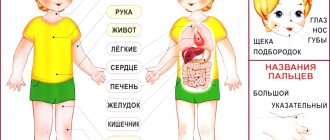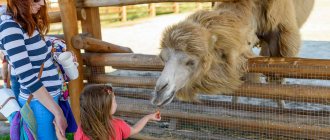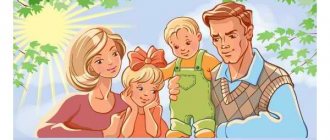Homework for parents of children 4-5 years old with ODD
Lexical topic “Summer. Summer changes in nature." Sound[s].
1. Color the picture (an adult colors it)
2. What time of year is this? Why do you think so? (It has become warm. The sun is shining and warming. The trees and bushes are green.
There are many flowers in the forest and meadow).
3. Listen to the story:
Summer has come, it has become hot. The water in the river is warm. Petya and Kolya are riding a boat. Dima and Mitya are swimming. Tima and Katya are playing ball. Lena and Masha are sunbathing. Vika and Tolya are picking strawberries. How nice it is in summer!
4.Answer the questions:
What happened? How is it outside? What is the water like in the river? What are Petya and Kolya doing? Show them.
What are Dima and Mitya doing? Show them. What are Tima and Katya doing? Show Tim, Katya.
What are Lena and Masha doing? Show them. What are Vika and Tolya doing? Show it to Vik, Tolya.
5.Retell the story. (If the child could not retell the story, then read it again. Invite the child to retell it again.)
6. Invite your child to guess the riddle.
The grove smells of strawberries, the sun burns your cheeks. Guess and tell me: when does this all happen? (In summer)
7. Strengthen the articulation of the sound [s].
8. Play the game “Catch the Word.” The adult names different words, the child claps out only words with the sound [s]: mask, milk, pussy, swallow, sleep, mouse, nose, wheel, boots, bench, aquarium, scales, basket, vacuum cleaner, goat, pineapple, soda, car, mustache, rose, wasps, astronaut.
9. Pronounce the phrase with the sound [s] behind an adult several times clearly, calmly, expressively (loudly, quietly, in a whisper):
At night it is quiet in the old house, only a mouse rustles in the straw.
Generalization on the lexical topic “Autumn”. Sounds [a], [u], [i].
1. Color the picture (an adult colors it)
2. Fix the season with your child - autumn
and ask him to say this word several times.
Fix in your speech the answer to the question: what time of year is it now? (It’s autumn now.)
Train your child in pronouncing this phrase. Reinforce the signs of autumn.
it has become cold
outside
it rains
often on the trees
have turned red or yellow,
they
are falling, there are fewer butterflies and beetles, birds are flying away,
from gardens and orchards
.
Say these phrases with your child and ask him to independently talk about autumn.
3.Look at the picture “Autumn” with your child. Explain to him why autumn is drawn in the picture. Draw his attention to the gloomy sky, dark clouds, light rain, colorful leaves
in the trees,
birds flying away, children's clothes.
Ask your child to tell about autumn based on the picture. If he is at a loss, help him by asking questions:
• What time of year is it in the picture? (It's autumn.)
• What kind of sky? (The sky is gloomy.)
• What kind of clouds? (The clouds are dark.)
• How much rain is it coming? (It's raining lightly.)
• What kind of leaves are on the trees? (The trees have colorful leaves.)
• What do birds do? (The birds fly away.)
• How are the children dressed? Why? (It’s cold outside. The children are dressed warmly.)
4. Exercise for fingers “Autumn Leaves”.
Accompany speech with finger movements.
One, two, three, four, five, let's collect leaves. (Rhythmically clench and unclench your fists.)
Birch leaves, rowan leaves,
(Fold your fingers, starting with the thumb, on both hands).
we will collect poplar leaves, aspen leaves, oak leaves,
We'll take an autumn bouquet to mom. (“Walk” on the table with the middle and index fingers of both hands).
5. Strengthen the articulation of the sounds [a], [u], [i]. Play the game “Name the first sound.” The adult names different words, the child names the first vowel sound in the word: stork, duck, willow, turkey, dill, alphabet, aquarium, hut, iron, street, toys, turkey, pharmacy, address, car, ears, Ira, snail.
Generalization on the lexical topic “Winter”. Sounds [a], [u], [i], [o].
1. Color the picture (an adult colors it)
2. Talk to your child about the season - winter. Fix the signs of winter: in winter the ground is covered with snow, the rivers are covered with ice, there are severe frosts, snowfalls, blizzards, people dress warmly, children ski and sled.
Fix the answer to the question: what time of year is it now?
(It’s winter now.)
1. Look at the picture “Winter” with your child. Ask your child questions and help him answer them with complete answers, giving a sample if necessary:
What time of year is it in the picture? (The picture shows winter.)
Why do you think so?
(There is snow on the ground. Snowflakes are spinning in the air. Bullfinches are sitting on a tree.)
How are the children dressed?
Why? (The children are dressed warmly. It’s cold outside.)
What are the children doing?
(Children are making a snowman.)
3. During a walk, talk with your child about winter, and together with him name the signs of winter (they are highlighted in the second paragraph). Consider how different snowflakes are. Show your child and help him remember: snow is white, fluffy, cold, soft; ice is hard, smooth, shiny.
Say these phrases several times.
4. Help your child write a story about winter using questions: What time of year is it? (Winter came.)
What lies around?
(There is snow all around.)
What's on the river?
(Ice on the river).
What's on the street?
Why is it cold? (It’s frosty outside.)
What’s everything like around you?
(Everything around is white.)
What are the children doing?
(Children sledding...)
Repeat the story yourself: “Winter has come. There is snow all around. Ice on the river. It's frosty outside. Everything around is white. Children are sledding".
Then the child speaks.
5. Train your child in pronouncing words: snowdrift, snowflake, icicle, snowfall, flakes.
6. Read the poem to your child and try to learn it:
I'll sprinkle sand thickly all over the path at the gate,
and also steps, descents, because there is ice.
(V. Nishchev)
7. Exercise for fingers “Walk”. Accompany speech with finger movements.
One, two, three, four, five, (Bend fingers one at a time)
We came to the yard for a walk. (“Walk” along the table with the index and middle fingers)
They sculpted a snow woman (“They sculpt” a lump with two palms)
The birds were fed crumbs (crushing movements with all fingers)
Then we rode down the hill, (Run the index finger of the right hand along the palm of the left hand)
And they were also lying in the snow. (Place palms on the table, first one side, then the other)
Everyone came home covered in snow. (Dust off palms)
We ate soup and went to bed. (Movement with an imaginary spoon; hands under cheek)
5. Strengthen the articulation of sounds [a], [u], [i], [o]. Play the game “Name the first sound.” The adult names different words, the child names the first vowel sound in the word: stork, duck, willow, cloud, etc.
Generalization on the lexical topic “Spring”. Sounds [a], [u], [i] [o], [s].
1. Color the picture (an adult colors it)
2. Talk with your child about the time of year that has come. Say the word spring with your child ,
teach how to answer the question: what time of year is it now?
(It’s spring now.)
Draw the child’s attention to the fact that in spring
the snow melts, thawed patches appear, ice begins to drift, birds fly in, the sun warms up, and streams run.
Practice the pronunciation of these phrases with your child. Remember that your speech should be a model for him. Insist that he tries to speak as clearly as possible.
3. Look at the picture with your child on the topic “Early Spring”. Help him write a story based on the picture using several sentences. Spring has come. The sun is shining brightly. Snow is melting. Streams are flowing. Children launch boats.
If your child finds it difficult, first help him answer the following questions:
• What time of year is it in the picture? (The picture shows spring.)
• What does the sun do? (The sun is shining brightly.)
• What does snow do? (Snow is melting.)
• What do streams do? (Streams are running.)
• What are the children doing? (Children launch boats.)
3.Read your child a poem about spring. Offer to play the game “Give me a word.”
There is a flock of cheerful birds outside the window, making so much noise that there is no time for sleep.
(spring) has come to us again
(V. Nishchev)
5. “Answer correctly.” Development of auditory attention.
In spring, is the sun warm or cold?
Norms of speech development
By this age the child:
- distinguishes sounds, selects the desired phoneme in a word;
- can pronounce words with complex syllable structure and consonant clusters;
- can determine how many syllables are in a word;
- uses complex sentences in speech;
- uses prepositions in his speech;
- masters the skill of coordinating words in a sentence;
- masters all methods of word formation;
- understands speech addressed to him;
- understands the hidden meaning of works of art;
- uses more and more words in coherent speech;
- without the help of an adult, composes descriptive stories, retells fairy tales and other works;
- can provide logical arguments to support a point of view or answer to a question;
- uses constructions with the conjunction “A”;
- understands logical and grammatical structures.
By the age of 7 years, children with normal speech development master the listed skills in full.
Tasks for the development of coherent speech
During this age period, speech therapy classes pay a lot of attention to coherent speech. The lessons teach:
- compose a descriptive story using pictures;
- answer with detailed sentences;
- use prepositions and conjunctions in speech;
- write a story on a given topic.
In addition, tasks for the formation of coherent speech develop imagination and linguistic sense, which is important for further learning at school.
- The adult invites the child to compose a fairy tale together.
- Call the child a proverb and offer to explain what it is about. Then together they make up a story so that it matches the meaning of the proverb.
- The speech therapist offers children a set of words from which they need to compose sentences or a story.
At the beginning of classes, you can use pictures to compose stories. The speech therapist helps with clarifying questions. The development of coherent speech is well influenced by theatrical performances and puppet theater. In such classes you can also practice diction, develop the ability to control voice modulations and intonation expressiveness.
Recommendations for parents
It is important that not only teachers, but also parents are involved in speech development. At this age, they are already preparing for school, so if the child speaks poorly, you need to seek help from a speech therapist and also follow his recommendations.
- Talk to your son or daughter more often, ask how your day was or any event you went to together.
- Be sure to read age-appropriate pieces and discuss what you read.
- Play board games with your child that are suitable for children aged 6-7 years.
- If sound pronunciation is impaired, be sure to do articulation exercises.
- Children like to make up words - this game not only has a beneficial effect on the development of speech, but also on the development of the mental function.
The age of 6-7 years is an important period in a child’s life. He is already preparing to enter school, his speech is becoming similar to the speech of an adult. The tasks and exercises offered by a speech therapist are a preventive measure to prevent the occurrence of dysgraphia and dyslexia. Competent speech is an important component of successful literacy learning.
Signs of speech development disorder
If a child has any deviation, his speech in basic indicators will lag behind the norm. This can be determined by the following signs:
- confuses sounds by ear, has difficulty identifying them in a word;
- has difficulty mastering sound-letter analysis;
- communicates with others using simple sentences, omits prepositions;
- the agreement of words in a sentence is disrupted or there is difficulty in agreeing certain parts of speech;
- difficult to understand complex speech structures;
- has difficulty understanding hidden meanings in stories and abstract concepts;
- the number of words used in speech is limited;
- composes a story or retells it with the help of adults;
- it is difficult to understand and draw up logical chains;
- low need to communicate with others.
If by the age of 6-7 years the listed deviations in speech development are observed, it is necessary to conduct speech therapy classes and perform special exercises for this age category of children.









